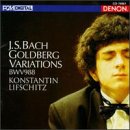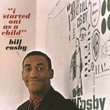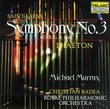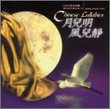| All Artists: Johann Sebastian Bach, Konstantin Lifschitz Title: Bach: Goldberg Variations Members Wishing: 0 Total Copies: 0 Label: Denon Records Release Date: 5/23/1995 Genre: Classical Styles: Historical Periods, Baroque (c.1600-1750) Number of Discs: 1 SwapaCD Credits: 1 UPC: 081757896122 |
Search - Johann Sebastian Bach, Konstantin Lifschitz :: Bach: Goldberg Variations
 | Johann Sebastian Bach, Konstantin Lifschitz Bach: Goldberg Variations Genre: Classical
Not since Glenn Gould's debut recordings has a young pianist tackled this challenging work with similar executional ease and unbridled joy. Konstantin Lifschitz blends heart, mind, and fingers in a way that makes Bach's te... more » |
Larger Image |
CD DetailsSynopsis
Amazon.com Not since Glenn Gould's debut recordings has a young pianist tackled this challenging work with similar executional ease and unbridled joy. Konstantin Lifschitz blends heart, mind, and fingers in a way that makes Bach's textural complexities clear with a minimum of fuss. What marvelous music-making, and to think the pianist was sixteen when he recorded this! Lifschitz observes all the repeats. --Jed Distler Similarly Requested CDs
|
CD ReviewsIf Richter had recorded the Goldbergs ... Daniel J. Rose | Shrewsbury, MA USA | 12/10/2000 (5 out of 5 stars) "This is what they might have sounded like. Without a doubt, it is one of the finest recordings of the "Goldberg Variations" and one of the finest solo piano recordings, period. It justly deserved the Grammy nomination it received when it was first released. Konstantin Lifschitz was, indeed, 16 when he recorded it, and shows all the technical brilliance of the young Glenn Gould when Gould first recorded it (for example, in ASIN B00006FI7C). However, even at the tender age of 16, Lifchitz brings dimensions to his performance that Gould never attempts. First, unlike Gould, he takes all the repeats. This provides an opportunity for frequent and inspired variations on the variations that often reveal "hidden" foundations of the score itself. Lifschitz's variety of touch and articulation combined with a solid command of tempo and the broader shape of the music can fill an encyclopedia. At the same time, his rhythmic intensity, whether slow or brilliantly fast, is always powerful. After listening to this performance and some others that have come along since, such as the outstanding effort by the reborn Murray Perahia (ASIN B00004Z3PV), I continue to return to it. So, my preferences generally run, in order, toward Lifschitz, Gould, and Perahia, who to my mind represent the three finest piano interpreters of this literally monumental work. (A recent and undeniably virtuosic effort by Gavrilov (ASIN B000025I53) suffers, simply because of its perfunctory, and sometimes rushed, virtuosity.) Lifschitz, in particular, as Peter Woodard (chair of the Hartt School Jazz Theory department) has noted, brings a noticably Richterian approach to the work. If you know Sviatislav Richter's recording of the "Well-Tempered Klavier," you can well imagine how he might have recorded the "Goldberg Variations." Lifschitz seems to have resurrected Richter's expansive style, and together with his debt to Gould, has also added some unique touches of his own. Where Gould masters a relentless, but appropriately varied pulse that flawlessly renders his piano version as if he were playing an expanded harpsichord, Lifschitz adds a much richer vocabulary of touch, voicing, and registration that is no less clear, but which reveals a pianistic Bach of much greater scope than Gould seems to envision. Perhahia does much the same, as a pianist, but with one key difference. Like Gould, Lifschitz brilliantly chooses the tempi of his variations to match simple ratios from one to the other. One variation will follow the next in either the same tempo or twice as fast, or three times as fast, or even in a 2 over 3 ratio, for example. The effect is one in which each variation moves forward into the next forming a larger whole, a single work, rather than a collection of separate miniatures. What heightens this effect, especially, is that Lifschitz plays the first five variations almost without a break (except to deftly lead a change in tempo), and he does all his repeats without breaks as well. Perahia, in comparison treats each variation, and sometimes half a variation, as a world unto itself, identifying and embellishing its own unique character, with its own unique tempo, each one shown brilliantly apart from the others. Perahia's additional embellishments in many of the repeats also serve to focus his detailed attention on each individual variation. Finally, unlike both Gould and Perahia (but much more like Richter), Lifschitz plays "into the keys." By holding every note, even his short staccato, to its maximum length, he seems to stretch every measure without actually dragging the tempo. The feeling, then, is one of relentless movement that is somehow never hurried, which just adds to the bigness in the Bach that Lifschitz exudes. Perhaps the best example of this is Variation 16, whose first part represents a recitative introduction to the gigue-like second part. Lifschitz (unlike most) fully realizes the stately, elephantine, pace of the recitative, then leaps into the gigue-like conclusion with the abandon and ease of a cat, but none of it either bogs down nor is hurried. The overall conception culminates in the final variation where Lifschitz beautifully renders one of the two complementary themes as the main theme and then subordinates it to the other with each repetition. The book-ended Aria is unsurpassed, again, in its stretched but steady movement, which decelerates with a simple but relentless gravity to its ultimate and almost never end. I never tire of hearing this recording and have listened to it many more times than either of the brilliant Gould and Perahia efforts. However, all three players (as has Gould by tradition) represent perhaps the pinnacle of their approach to this infinitely rich work. If I tend to prefer Lifschitz, it may only be because I am a Richter fan of long standing who has often wondered at the Goldbergs that might have been, and that just now may be from the still unheralded hands of this fine and unlikely young player. " Astonishing 03/01/2003 (5 out of 5 stars) "The command with which this work is performed very nearly leads the listener to imagine Mr. Lifschitz a medium through whom the music is being channeled; the ecstatic, personal quality of his performance, however, disavows one of the notion. As observed by Mr. Distler, Mr. Lifschitz observes all the repeats. This has the effect of making me feel as though I'm being introduced to the Goldberg Variations on piano for the first time. Very different in spirit than either of the Goulds, but not, in my opinion, less enjoyable (although Gould really is in a class by himself). One wonders what Gould's opinion of them would have been. Mr. Lifschitz does not hum." Not just good as a 16-year old, but absolutely wonderful! 09/27/2001 (5 out of 5 stars) "I am a Bach buff, especially his keyboard pieces. Goldberg Variations are my favorite. I got this CD because I was curious how such a young pianist handled this monumental work that demands maturity as well as absolute virtuosity. When I listened to the CD for the first time, I was amazed that 16 years old Konstantin Lifschitz played Goldberg Variations nearly perfectly (just to clarify I do not believe a human being can achieve perfection) with confidence and maturity. He brought out polyphonic voices with exceptional clarity. He played each piece of the variations in a distinct manner such as tempo, dynamics, articulation and mood. He is not just good as a 16-year old, but he is phenomenal as a world-class pianist. If you want to listen to great Goldberg Variations, buy this CD. You won't be disappointed."
|

 Track Listings (32) - Disc #1
Track Listings (32) - Disc #1

